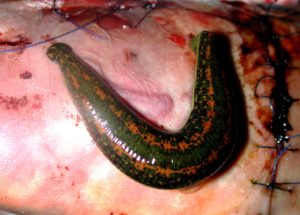Hirudotherapy
HIRUDOTHERAPY
 Hirudotherapy is the use of medicinal leeches (usually Hirudo medicinalis or Hirudo verbana) for curative purposes.Leeches have enjoyed a renaissance in reconstructive microsurgery during thelast 30 years. Nowadays, medicinal leech therapy is considered an integral part ofthe armamentarium to salvage vascular compromised flaps or replants. In the 21st. Century, several clinical studies were performed in Germany and Russiato demonstrate the healing effect of leeches in the treatment of painful osteoarthritis.
Hirudotherapy is the use of medicinal leeches (usually Hirudo medicinalis or Hirudo verbana) for curative purposes.Leeches have enjoyed a renaissance in reconstructive microsurgery during thelast 30 years. Nowadays, medicinal leech therapy is considered an integral part ofthe armamentarium to salvage vascular compromised flaps or replants. In the 21st. Century, several clinical studies were performed in Germany and Russiato demonstrate the healing effect of leeches in the treatment of painful osteoarthritis.
Currently, in some countries of Eastern Europe, Russia and Asia hirudotherapy is officially recognized as a classic alternative therapy of diseases and symptoms suchas phlebitis, osteoarthritis, hypertension and glaucoma.
The choice of indications and contraindications, the number of leechesapplied, optimal techniques, the regimen of leech therapy, supplemental antibacterialtherapy in high-risk patients as well as monitoring of the patient, are ofparamount importance.
The saliva of H. medicinalis contains more than 100 bioactive substances, includingcoagulation inhibitors, platelet aggregation inhibitors, vasodilators, as well asanaesthetizing, antimicrobial and anti-inflammatory agents..
One of the most important ingredients is hirudin, which is the principal anticoagulantresponsible for enhanced bleeding and prevention of coagulation.Furthermore, leech saliva is an effective platelet aggregation inhibitor due tothe presence of active ingredients such as calin, apyrase (adenosine diphosphatase),platelet activating factor (PAF)- antagonist, collagenase and prostaglandin.
Their main function is to induce secondary bleeding, which can last several hoursafter the end of each leech session. Calin binds collagen, a natural blood clotting factor that suppresses collagen-induced platelet aggregation.A mammalian- type collagenase may inhibit collagen-induced platelet aggregation,and increase tissue permeability. Together with plasmin, collagenase helps reduce fibroblast formation in hypertrophic scars and keloids. The PAF-factorantagonist in addition to its role as an aggregation inhibitor can prevent inflammation. Apyrase and prostanoid components isolated from leech salivaimpede ADP- induced platelet aggregation. Destabilase enzyme from the H. medicinalis saliva depolymerizes soluble cross- linked fibrin and gives leeches the ability to lyse clots by means of specific fibrinolysis and disaggregation. It has beenestablished that large quantities of endo-isopeptides, which are lysed by destabilaseenzymes, are detected in affected tissues of patients with atherosclerosis, diabetesmellitus, cataracts and pancreatitis. In addition, destabilaseexhibits combined enzymatic and non-enzymatic antibacterial action. The destabilase binds free hirudin and plasma kallikrein inhibitors in a rugged liposome-like destabilase complex that can penetrate through the cellmembrane.
Leeches may also secrete a vasodilatory, histamine-like substance, whichincreases the inflow of blood after a leech bite, and reduces local swelling.Hyaluronidase, known as the “spreading factor”, can degrade tissuehyaluronic acid, thus facilitating the infiltration and diffusion of the remainingingredients of leech saliva into the congested tissue.
References
Mumcuoglu KY, Pidhorz C, Cohen R, Ofek A, Lipton HA. 2007. The use of the medicinal leech, Hirudo medicinalis, in the reconstructive plastic surgery. Internet J Plastic Surg.. 4 (2): 1-9. pdf
Michalsen A, Lüdtke R, Cesur O, Afra D, Musial F, Baecker M, Fink M, DobosGJ. 2008. Effectiveness of leech therapy in women with symptomatic arthrosis of the firstcarpometacarpal joint: a randomized controlled trial. Pain. 15;137:452-9. doi: 10.1016/j.pain.2008.03.012. pdf
Gilyeva OS, Mumcuoglu KY. 2013. Hirudotherapy. In: Grassberger, M., R.A. Sherman, O. Gileva, C.M.H. Kim & K. Y. Mumcuoglu (Eds). Biotherapy – History, Principles and Practice: A Practical Guide to the Diagnosis and Treatment of Disease using Living Organisms. Springer Pub., Heidelberg, pp. 31-76.
Elyassi AR, Terres J,RowshanHH. 2013.Medicinal leech therapy on head and neck patients: a review of literature and proposed protocol.Oral Surgery, Oral Medicine, Oral Pathology and Oral Radiology, 116: 167–172. pdf
Mumcuoglu KY. 2014. Recommendations for the use of leeches in reconstructive plastic surgery. Evidence-Based Complementary and Alternative Medicine, Vol. 2014, Article ID 205929, 7 pages, pdf
Herlin C, Bertheuil N, Bekara F, Boissiere F, Sinna R, Chaput B. 2016. Leech therapy in flap salvage: Systematic review and practical recommendations.Ann ChirPlastEsthet. pii: S0294-1260(16)30091-7. doi: 10.1016/j.anplas.2016.06.004. pdf
Registration Form
International Course in Maggot Therapy Registration Form We look forward to welcoming you to the International Maggot Therapy Course in Izmir, TürkiyeDownload Registration Form > Executive Committee Society Members Membership...
Registration Form
International Course in Maggot Therapy Registration Form We look forward to welcoming you to the International Maggot Therapy Course in Izmir, TürkiyeDownload Registration Form > Executive Committee Society Members Membership...
